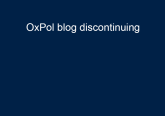In a recent post on this blog Nigel Bowles argued that Donald Trump will largely be able to carry out his policy agenda when he becomes US president in January. In this post Colin Provost joins the debate, concluding that in the areas of trade, health care, financial regulation and climate change Trump is likely to run into major obstacles. This is because many of Trump’s campaign pledges involve large, complex governing systems and he will have limited control over these systems in their entirety.
Nigel Bowles recently wrote on this blog that President-Elect Trump will be able to push through key parts of his policy agenda in the coming four years, because of the powers afforded to him by the US Constitution and because collective action problems within Congress will prevent meaningful attempts to block his agenda. Many of Dr Bowles’ points are correct and some scholars may argue he does not go far enough in articulating the strengths of the administrative presidency. However, President-Elect Trump has made numerous grandiose promises which potentially affect large policy making networks. The more groups he touches, the more resistance he possibly engenders, thereby making policy making a grinding and tortuous battle. In this post I look at Trump’s proposals for trade, health care, financial regulation and climate change and conclude that his administration is likely to run into major obstacles in each of these areas.
As Dr Bowles has articulated, Donald Trump benefits from collective action problems in Congress and a broad range of constitutional, as well as unilateral, powers. Since the Nixon administration, every president has presided over what Richard Nathan referred to as the “administrative presidency“. The president ideologically steers dozens of federal agencies through appointments, s/he can also impose new substantive and procedural requirements on agencies through the use of executive orders, and s/he can employ ‘signing statements’ which enable the president to specify which parts of the law by which s/he would abide. Perhaps most importantly, Terry Moe and William Howell have argued that the Constitution’s language that the president ‘shall take care that the laws be faithfully executed’ builds ambiguities and discretion into the formal power structure that the president can shrewdly exploit.
Moreover, Trump will have Republican majorities in Congress, as well as a conservative Supreme Court after Trump likely pushes aside Merrick Garland in favour of a more conservative nominee. However, many scholars have noted in recent decades how we no longer study ‘government’, but ‘governance’. Implicit in this concept is the idea that governing is performed by a very large coalition of actors involved not only in a national government, but in subnational governments, in foreign governments, in markets, in non-governmental organisations, in the media, in think tanks and so on. These actors do not all represent veto players of equal power, but taken together, creative means of resisting policies can often be formulated and applied. When we look at some of the President-Elect’s proposals closely, we can envision how his proposals may not be implemented to the extent he would prefer.
First, let us take Trump’s signature issue of trade, where he promised better deals to help American blue collar workers. As Dr Bowles pointed out, Trump has broad authority to alter trade deals, alterations that can have a significant impact on American businesses and workers. But this point should not be overestimated. In the global economy, products are assembled over a number of different countries. As a result, trying to craft precisely punitive trade measures aimed at particular nations, or even companies, is an exceedingly difficult task. An example from the George W. Bush administration serves to illustrate this point well. In 2002, armed with a U.S. International Trade Commission report that showed the American steel industry had been harmed by steel imports, President Bush levied tariffs as high as 30 per cent on numerous different types of imported steel. The tariffs were supposed to assist the steel industry, but many observers believed the move was designed to curry favour with voters in the steel-manufacturing states of Pennsylvania, Ohio and Michigan.
Recent research by Kenneth Lowande, Jeff Jenkins and Andrew Clarke suggests that presidents routinely adjust tariffs to enhance electoral prospects, but this does not mean such moves are costless. In the steel tariff case, outrage was expected from steel-exporting nations, but the administration did not anticipate the vocal complaints from American steel-consuming industries whose production costs subsequently skyrocketed. At the time, the Consuming Industries Trade Action Coalition found that 200,000 jobs had been lost as a result of the tariffs, a number that exceeded the total number of people working in steel manufacturing at the time. Facing these unexpected job losses, as well as potential retaliatory tariffs from other nations, with equally negative effects, Bush rescinded the tariffs in late 2003.
In late November, Donald Trump negotiated his deal with the Indiana-based company Carrier to keep 1,000 jobs in the U.S in exchange for tax incentives. This achievement has emboldened Trump to claim that other American companies that move jobs overseas and then export back to the U.S. will face 35 per cent tariffs, but pushing through such measures will be dangerous, if not difficult. First, the Bush Administration example provides a good lesson in how punitive trade measures can not only provoke counter-tariffs in a tit-for-tat fashion, but they can also unexpectedly hurt domestic industries that consume the newly-taxed good.
Second, Trump’s language suggests he believes that he can employ a surgical strike of targeting particular companies, while in reality, any tools at his disposal are more on the order of carpet-bombing entire industries. Trump may try to enact tariffs in the name of jobs, security, or unequal regulatory standards across nations, but it is not clear how he can create such specific trade measures, without harming a broader swathe of companies that export to the U.S. Finally, on December 5, a number of House Republicans publicly expressed opposition to such tariffs. Thus, while the President-Elect does have the authority to restrict trade unilaterally, such moves are rarely costless and he does so at his own electoral peril.
Second, on Obamacare, Dr Bowles is absolutely correct that Trump and Congressional Republicans will have a very challenging time moving forward with a repeal. Trump has expressed a willingness to keep only parts of the law, but most health-care experts have roundly condemned cherry-picking Obamacare’s greatest hits as unworkable in practice. For example, if we did away with the individual mandate to buy health insurance, but continued to ensure that insurance companies did not discriminate against people with pre-existing conditions, then young, healthy people may forego health insurance, leaving the industry with a disproportionately high number of sick people, driving up the cost of health care. If we did away with the pre-existing condition rule, then insurance companies could freely discriminate, but then millions of people who need health insurance would be at risk of losing it.
Some Congressional Republicans are in touch with this reality and have proposed a plan of ‘repeal and delay’, in which Obamacare is repealed and Republicans are given some window of years to put together a replacement. Such a long period of regulatory uncertainty would wreak major havoc in health insurance markets, but if Republicans repealed and replaced immediately with say, expanded tax credits, it is not clear how many people would be able to afford new or keep existing health insurance plans under the new regime, with no mandate and lighter requirements of insurance companies. Thus, repealing is the easy part, but replacing is going to be significantly more difficult.
Third, Trump also promised to repeal President Obama’s signature piece of financial market reform, known as Dodd-Frank. Many observers have noted that smaller, community banks have suffered disproportionately under the regulatory weight of Dodd-Frank. The financial industry has also complained loudly about the Consumer Financial Protection Bureau (CFPB) and the way its rules target specific instruments and practices, such as payday lending and mandatory arbitration. Despite the organisational clout and resources of the banking industry and its congressional allies, it is not clear that a broader appetite exists to repeal Dodd-Frank, as it was the main regulatory response to the Financial Crisis. Rather than spend significant capital, marshalling the necessary resources for a full repeal, Trump is likely to use a more executive strategy, in an effort to chip away at the foundation of Dodd-Frank.
The D.C. Circuit Court of Appeals ruled before the election that the CFPB’s leadership structure of a single agency appointee who could only be sacked for cause was unconstitutional and needed change. The case could still be appealed to a full panel of the D.C. Circuit, and later the Supreme Court, giving Trump the chance to restructure the top of the agency. However, even with this prospect, the states can still flex their muscles as Dodd-Frank gives them the power to enforce federal and state law. Under the Obama administration, Democratic state attorneys general (AGs) typically worked in concert with the CFPB, while under President Trump, they would act more as a counter-weight to the executive branch. This explicit grant of power would also prevent the sort of federal pre-emption that stopped Bush-era state AGs from enforcing even state laws against federally chartered banks.
Finally, on environmental policy, Trump is likely to struggle to roll back developments in renewable energy while heralding a renaissance for fossil fuels. I have written elsewhere that he will be able to get his desired appointments through Congress, he will be able to write new executive orders governing the drafting of new regulatory rules and he might succeed in replacing President Obama’s Clean Power Plan with something considerably less stringent. Despite these gains, the movement to develop renewable energy and combat climate change will proceed, regardless of the Trump administration’s preferences.
First, President-Elect Trump will not be able to withdraw the U.S. from the Paris Climate Agreement without some acrimony erupting between the U.S and its allies. So, the administration is more likely to pursue a policy of climate inaction, while embracing fossil fuels. However, Democratic state AGs have experience suing Republican presidents for lax enforcement of the Clean Air Act, and they will not hesitate in this instance either. Additionally, Trump has vowed to revitalise the coal industry, but with abundant natural gas replacing coal in electricity markets, it is difficult to see how he can accomplish this, without heavily subsidizing coal – a move that he would be at pains to justify. Finally, the continued development of solar and wind power has bipartisan support in Congress and Trump would struggle to discontinue financial support. And the Obama Administration has taken steps to make such development even easier, most recently by creating a transparent bidding system to develop clean energy sources on federally owned land.
To conclude, we should not delude ourselves about what the Trump administration can accomplish. He is presiding over a vast federal bureaucracy, with majorities in Congress and across most state governments. However, steering this bureaucracy towards one’s desired policy goals requires a very wide berth, as well as a significant period of time. Most of Trump’s campaign promises involve large, complex governing systems and he has limited control over these systems in their entirety. Unless he scales back his ambitions he will be at risk of significantly alienating many actors within these systems, hurting his own chances for re-election.
This post was originally published on the Constitution Unit blog and is re-posted with permission.






